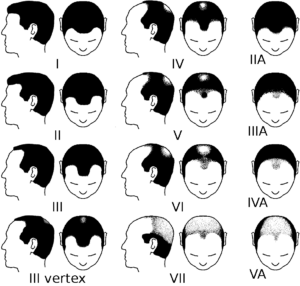Hair loss can be caused by a variety of factors. The most common is male pattern baldness, affecting around half of all men by the age of 50. It usually starts around the late twenties or early thirties – most men have some degree of hair loss by their late thirties. Male pattern baldness runs in the family.
There are a few types of hair loss, these are:
• Androgenic alopecia (a.k.a male/female pattern baldness)
• Alopecia areata – an autoimmune disorder where patches of baldness usually the size of a large coin appear on the body. In most cases, the hair will grow back but will take time
• Scarring alopecia – caused by a complication of another condition where the hair follicle is destroyed. Conditions such as scleroderma, lichen planus, folliculitis decalvans, and others
• Anagen effluvium – widespread and can affect the whole body. The most common cause is chemotherapy. In most cases, this is temporary and will regrow after treatment is stopped
• Telogen effluvium – widespread thinning of the hair. In most cases, it will stop and regrow after around 6 months. This can be caused by hormonal changes, stress, changes in diet, and certain illnesses
Male Pattern Baldness
This is caused by excess dihydrotestosterone (DHT which sex hormone – a body & facial hair growth promoter.
The first sign of male pattern baldness is the thinning of the crown and/or a receding hairline.
It is best to start tackling hair loss when you first notice it – the sooner you start the more likely the chance of the treatment being successful
Most Common Treatments for Male Pattern Baldness
Finasteride 1mg and Minoxidil foam/liquid are the most common treatments available.
Finasteride is a 5-reductase inhibitor – this inhibits 5-reductase which stops testosterone being converted into DHT. Therefore, less DHT in the body means less hair loss.
Minoxidil comes as either 2% or 5%. There is no preference for what strength to start on but the 5% has a higher chance of scalp irritation. This works by increasing blood flow to the scalp, reversing the miniaturisation of follicles, and stimulating follicle growth.
Minoxidil requires a twice daily application whereas finasteride is a once daily tablet.
Get Help for Your Hair Loss
Losing your hair is typically not a cause for concern, but it can understandably be distressing. Hair often plays a significant role in one’s identity. If your hair loss is causing you emotional distress, consider visiting your local GP for counselling support.
View Hair Loss Treatments
Sources:
- NHS – Hair Loss
- Messenger, A. G., & Sinclair, R. D. (2008). Follicular miniaturization in female pattern hair loss: Clinicopathological correlations. Journal of the American Academy of Dermatology, 59(5), 780-786. Available at: ScienceDirect


